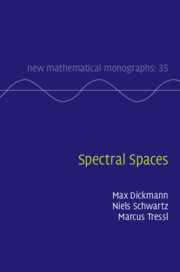Book contents
- Frontmatter
- Contents
- Preface
- An Outline of the History of Spectral Spaces
- 1 Spectral Spaces and Spectral Maps
- 2 Basic Constructions
- 3 Stone Duality
- 4 Subsets of Spectral Spaces
- 5 Properties of Spectral Maps
- 6 Quotient Constructions
- 7 Scott Topology and Coarse Lower Topology
- 8 Special Classes of Spectral Spaces
- 9 Localic Spaces
- 10 Colimits in Spec
- 11 Relations of Spec with Other Categories
- 12 The Zariski Spectrum
- 13 The Real Spectrum
- 14 Spectral Spaces via Model Theory
- Appendix The Poset Zoo
- References
- Index of Categories and Functors
- Index of Examples
- Symbol Index
- Subject Index
An Outline of the History of Spectral Spaces
Published online by Cambridge University Press: 08 March 2019
- Frontmatter
- Contents
- Preface
- An Outline of the History of Spectral Spaces
- 1 Spectral Spaces and Spectral Maps
- 2 Basic Constructions
- 3 Stone Duality
- 4 Subsets of Spectral Spaces
- 5 Properties of Spectral Maps
- 6 Quotient Constructions
- 7 Scott Topology and Coarse Lower Topology
- 8 Special Classes of Spectral Spaces
- 9 Localic Spaces
- 10 Colimits in Spec
- 11 Relations of Spec with Other Categories
- 12 The Zariski Spectrum
- 13 The Real Spectrum
- 14 Spectral Spaces via Model Theory
- Appendix The Poset Zoo
- References
- Index of Categories and Functors
- Index of Examples
- Symbol Index
- Subject Index
Summary
A review of some principal landmarks in the development of the theory of spectral spaces sheds some light on this special part of general topology. It explains the growing general interest in the subject and, in parts, our motivation for writing this book.
Spectral spaces first appeared through the work of Marshall H. Stone in [Sto37b]; one identifiable motivation was the quest for a topological representation of Brouwerian logic. Related to ideas of MacNeille's dissertation, cf. [Mac36] and Birkhoff's [Bir33], Stone extended his celebrated work on the duality between Boolean algebras and Boolean spaces ([Sto36], [Sto37a]) to the realm of distributive lattices. He introduced a topology on the set of prime ideals of a distributive lattice; the resulting space is nowadays called the spectrum of the lattice. Stone then singled out certain properties of the spectrum and proved in [Sto37b, Theorems 15,16] that any topological space with these properties is the spectrum of a distributive lattice; this is the birth of spectral spaces and the essence of Stone duality between distributive lattices and spectral spaces, cf. Chapter 3.
A spectral space is not Hausdorff, unless it is Boolean. As in Stone's earlier duality between Boolean algebras and Boolean spaces, the distributive lattice associated with a spectral space can be conceived of as an algebra of continuous functions. Explicitly, the Boolean algebra 2 = ﹛0, 1﹜ is topologized such that the singleton ﹛0﹜ is the only nontrivial open set. Then a distributive lattice is the lattice of continuous functions from its spectrum to 2.
It was quickly realized that arbitrary rings (not necessarily commutative) can be represented in a related way. Jacobson introduced a topology on the set of primitive ideals of a not necessarily commutative ring, [Jac45, p. 234], and called this the structure space. Jacobson refers to [Sto37a] and Gelfand– Silov, cf. [GeŠi41], for the topology he used. Even if he does not use Stone's work in a technical way, he seems to have taken inspiration from Stone. His way of defining the topology follows Stone's lead. Before Jacobson, roughly simultaneously with Stone, the study of rings of continuous functionswas under way. This research direction picked up speed in the 1940s, see the bibliography of [GiJe60] (which includes references to some of Stone's work).
Information
- Type
- Chapter
- Information
- Spectral Spaces , pp. xiii - xviiiPublisher: Cambridge University PressPrint publication year: 2019
